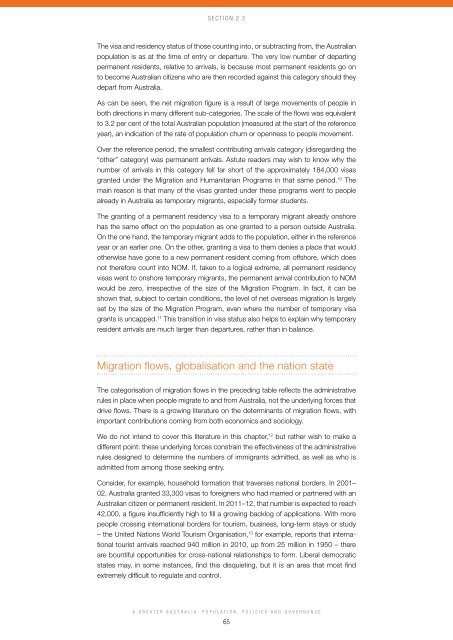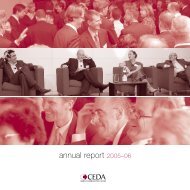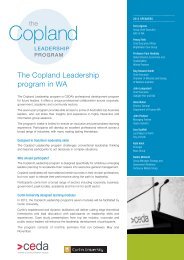A Greater Australia: Population, policies and governance - CEDA
A Greater Australia: Population, policies and governance - CEDA
A Greater Australia: Population, policies and governance - CEDA
- No tags were found...
You also want an ePaper? Increase the reach of your titles
YUMPU automatically turns print PDFs into web optimized ePapers that Google loves.
Section 2.2The visa <strong>and</strong> residency status of those counting into, or subtracting from, the <strong>Australia</strong>npopulation is as at the time of entry or departure. The very low number of departingpermanent residents, relative to arrivals, is because most permanent residents go onto become <strong>Australia</strong>n citizens who are then recorded against this category should theydepart from <strong>Australia</strong>.As can be seen, the net migration figure is a result of large movements of people inboth directions in many different sub-categories. The scale of the flows was equivalentto 3.2 per cent of the total <strong>Australia</strong>n population (measured at the start of the referenceyear), an indication of the rate of population churn or openness to people movement.Over the reference period, the smallest contributing arrivals category (disregarding the“other” category) was permanent arrivals. Astute readers may wish to know why thenumber of arrivals in this category fell far short of the approximately 184,000 visasgranted under the Migration <strong>and</strong> Humanitarian Programs in that same period. 10 Themain reason is that many of the visas granted under these programs went to peoplealready in <strong>Australia</strong> as temporary migrants, especially former students.The granting of a permanent residency visa to a temporary migrant already onshorehas the same effect on the population as one granted to a person outside <strong>Australia</strong>.On the one h<strong>and</strong>, the temporary migrant adds to the population, either in the referenceyear or an earlier one. On the other, granting a visa to them denies a place that wouldotherwise have gone to a new permanent resident coming from offshore, which doesnot therefore count into NOM. If, taken to a logical extreme, all permanent residencyvisas went to onshore temporary migrants, the permanent arrival contribution to NOMwould be zero, irrespective of the size of the Migration Program. In fact, it can beshown that, subject to certain conditions, the level of net overseas migration is largelyset by the size of the Migration Program, even where the number of temporary visagrants is uncapped. 11 This transition in visa status also helps to explain why temporaryresident arrivals are much larger than departures, rather than in balance.Migration flows, globalisation <strong>and</strong> the nation stateThe categorisation of migration flows in the preceding table reflects the administrativerules in place when people migrate to <strong>and</strong> from <strong>Australia</strong>, not the underlying forces thatdrive flows. There is a growing literature on the determinants of migration flows, withimportant contributions coming from both economics <strong>and</strong> sociology.We do not intend to cover this literature in this chapter, 12 but rather wish to make adifferent point: these underlying forces constrain the effectiveness of the administrativerules designed to determine the numbers of immigrants admitted, as well as who isadmitted from among those seeking entry.Consider, for example, household formation that traverses national borders. In 2001–02, <strong>Australia</strong> granted 33,300 visas to foreigners who had married or partnered with an<strong>Australia</strong>n citizen or permanent resident. In 2011–12, that number is expected to reach42,000, a figure insufficiently high to fill a growing backlog of applications. With morepeople crossing international borders for tourism, business, long-term stays or study– the United Nations World Tourism Organisation, 13 for example, reports that internationaltourist arrivals reached 940 million in 2010, up from 25 million in 1950 – thereare bountiful opportunities for cross-national relationships to form. Liberal democraticstates may, in some instances, find this disquieting, but it is an area that most findextremely difficult to regulate <strong>and</strong> control.A <strong>Greater</strong> <strong>Australia</strong>: <strong>Population</strong>, Policies <strong>and</strong> Governance65





